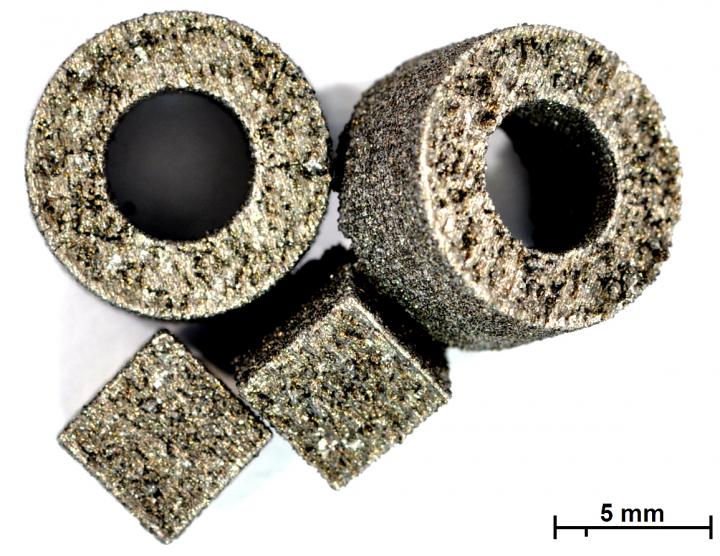
Credit: © IMAT – TU Graz
From wind turbines and electric motors to sensors and magnetic switching systems: permanent magnets are used in many different electrical applications. The production of these magnets usually involves sintering or injection moulding. But due to the increasing miniaturisation of electronics and the more exacting requirements, this places on magnetic components in terms of geometry, these conventional manufacturing methods are frequently coming up short. Additive manufacturing technologies, however, offer the required flexibility of shape, enabling production of magnets tailored to the demands of the application in question.
Tailor-made magnets
Researchers at TU Graz – in collaboration with colleagues from the University of Vienna and Friedrich-Alexander Universität Erlangen-Nürnberg (FAU) as well as a team from Joanneum Research in Graz – have now succeeded in manufacturing super magnets with the help of laser-based 3D printing technology. The method uses a powdered form of the magnetic material, which is applied in layers and melted to bind the particles, resulting in components made purely of metal. The team of scientists have now developed the process to a stage where they are able to print magnets with a high relative density while still managing to control their microstructures. “The combination of both these features enables efficient material use because it means we can precisely tailor the magnetic properties according to the application,” explain Siegfried Arneitz and Mateusz Skalon from the Institute of Materials Science, Joining and Forming at TU Graz.
The initial focus of the research group was the production of neodymium, or NdFeB, magnets. On account of its chemical properties, the rare earth metal neodymium is used as the basis for many strong permanent magnets which are crucial components for lots of important applications, including computers and smartphones. The researchers have published a detailed description of their work in the journal Materials. In other applications, such as electric brakes, magnetic switches and certain electric motor systems, the strong force of NdFeB magnets is unnecessary and also undesirable.
Search for alternatives to rare earths
For this reason, Siegfried Arneitz, a PhD student at TU Graz’s Institute of Materials Science, Joining and Forming, is continuing the research into 3D-printed magnets by building on the results achieved so far. He is writing his dissertation on the 3D printing of Fe-Co (iron and cobalt) magnets. These magnets represent a promising alternative to NdFeB magnets in two respects: mining rare earth metals is resource intensive and not very attractive from a sustainability standpoint, and the recycling of such metals is still in its infancy. But Fe-Co magnets are less harmful to the environment.
Rare earth metals also lose their magnetic properties at higher temperatures, while special Fe-Co alloys maintain their magnetic performance at temperatures of 200° to 400° Celsius and demonstrate good temperature stability.
Arneitz is upbeat about his initial findings: “Theoretical calculations have shown that the magnetic properties of these materials can be improved by a factor of two or three. Given the flexibility of shape that 3D printing offers, we’re confident we can get closer to this goal. We’re going to continue working on this topic in collaboration with various other institutes so we can develop alternative magnetic materials for areas in which neodymium magnets are not necessary.”
Various teams and institutes at TU Graz are working on additive manufacturing techniques, and have recorded a steady stream of research breakthroughs. To find out more, read the Planet Research article Additive Manufacturing: The 3D Revolution: https:/
###
This research project belongs to TU Graz’s Advanced Materials Science Field of Expertise, one of the university’s five strategic research focuses.
Original publication by Mateusz Skalon: Influence of Melt-Pool Stability in 3D Printing of NdFeB Magnets on Density and Magnetic Properties” in Materials 2020, 13, 139; [doi:10.3390/ma13010139]
Contacts for scientific enquiries:
Dr. Mateusz Skalon
TU Graz | Institute of Materials Science, Joining and Forming
Tel. +43 (0)316 873 4305
E-mail: [email protected]
imat.tugraz.at
Siegfried Arneitz
TU Graz | Institute of Materials Science, Joining and Forming
Tel. +43 (0)316 873 1656
[email protected]
imat.tugraz.at
Media Contact
Mateusz Skalon
[email protected]
43-316-873-4305
Original Source
https:/
Related Journal Article
http://dx.




